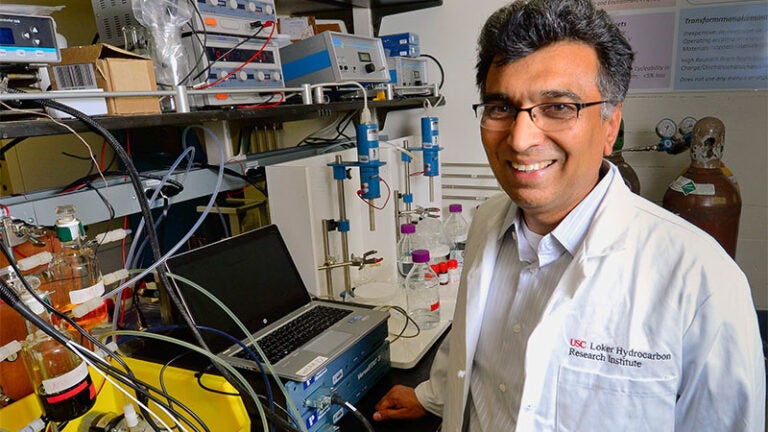
Chemist and sustainable energy innovator elected a Fellow of the National Academy of Inventors
Key takeaways:
- Sri Narayan is working on batteries that are sorely needed for green energy to fulfill its potential.
- His work could help make fossil fuels a relic.
- He hopes his work will also help global communities with little or no access to electricity.
From Benjamin Franklin to Madam C. J. Walker to Steve Wozniak, American inventors hold a particular fascination among their fellow citizens, often recognized and lauded as the backbone of progress for the country.
The National Academy of Inventors (NAI), established in 2010, recognizes these innovators and their contributions to society. Election as an NAI Fellow remains one of today’s most prestigious honors for inventors.
This year, Sri Narayan, professor of chemistry at the USC Dornsife College of Letters, Arts and Sciences, is among the latest group to receive this accolade.
Narayan is the third USC Dornsife faculty member to be elected an NAI Fellow, and he, along with Andrea Armani and Cyrus Shahabi of the USC Viterbi School of Engineering, who were also elected this year, raise the university’s overall tally of fellows to 21.
“I am pleased to be recognized by this illustrious and creative group of academic researchers and also to be joining a talented group of NAI Fellows at USC,” Narayan said. “Apart from the joy of recognition, my election as Fellow of the NAI reiterates that inventive and creative contributions by academia have a chance to be recognized as much as scholarship.”
Narayan investigates, among many things, how to build better batteries and how sunlight and carbon dioxide can efficiently be converted to electricity. His studies aim to reduce dependence on fossil fuels by making the generation of energy from renewable sources, such as wind and sunlight, more practical.
“The goal of my research and inventions is to address the global challenge of achieving net-zero carbon emissions through the pervasive use of renewable energy in all spheres of human activity,” he said, noting that he hopes his research also helps those struggling around the globe to meet their energy needs. “I want my work on batteries to reach the neglected segments of the world population who have no access to electricity.”
Before joining USC Dornsife and the USC Loker Hydrocarbon Research Institute in 2010, Narayan spent two decades at NASA’s Jet Propulsion Laboratory, where he spearheaded efforts to develop fuel cells and led the Electrochemical Technologies Group. While at JPL, he pioneered the use of methanol as a power source in fuel cells and worked to advance hybrid power sources for space and defense applications, among many projects.
His research at USC Dornsife aimed at developing new battery technologies includes the use of lithium-sulfur, which is safer than current lithium-ion materials and can hold as much as three times the energy while using abundant, less-expensive materials. He also works on iron-based batteries and liquid-based redox-flow batteries, technologies that hold particular promise for storing energy generated by renewable sources, such as sunlight and wind.
His work is available through more than 80 journal publications, and he holds more than four dozen patents.
Narayan, who has mentored numerous students during his career at USC Dornsife, sees his election as an NAI Fellow as another opportunity to share his enthusiasm for science and motivate future generations to work for the benefit of the planet.
“I hope I will be able to further inspire my students to exercise their creative talents to address the hardest global challenges of our time in energy, environment, health and equity.”